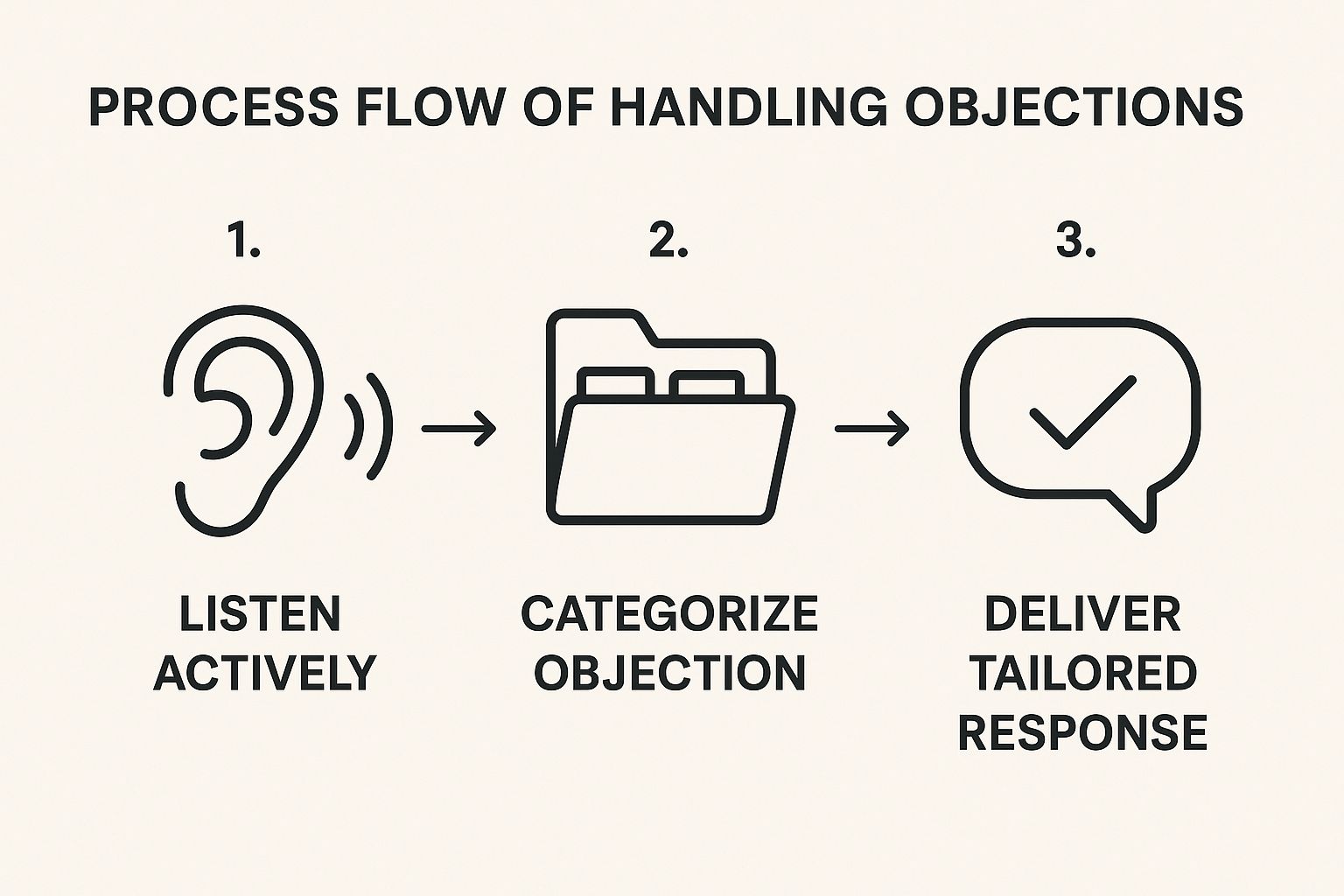It's time for a mental shift. When you hear an objection, what's your gut reaction? For many, it feels like a "no," a roadblock thrown up in your path. But the best sales professionals I know see it differently. They don't hear a "no"; they hear a request for more information.
This simple reframing turns a potential dead end into a genuine opportunity to dig deeper, understand what’s really on the prospect's mind, and build the kind of trust that actually closes deals.
Reframe Objections as Opportunities
Let's be real—no one loves hearing an objection. It can feel like you've hit a brick wall. But what if that wall is actually a door? A prospect's objection isn't a personal attack. It's a sign they're engaged.
The real deal-killer isn't a "no." It's silence. Apathy. An objection means your buyer is thinking critically about what you've offered, and that's a whole lot better than getting ghosted.
I once watched a colleague completely salvage a deal that seemed dead on arrival. The prospect laid it out plain and simple: "We're happy with our current provider and have no budget for this." Instead of packing it in, my colleague leaned in. He said, "I appreciate that. Could you help me understand what aspects of your current service you value the most?"
That one question changed everything. It kicked off a conversation that unearthed a pile of hidden frustrations they had with their current setup. The "no" wasn't a final answer; it was a test.
Adopt a Consultative Mindset
The secret is to stop being defensive and start being consultative. When you treat an objection as a clue—a request for more information—the entire dynamic of the conversation shifts. This is the core of some of the most effective objection-handling models out there.
Think of it as a four-part dance:
- Listen: Let them talk. Don't cut them off. Just absorb what they're saying.
- Acknowledge: Validate their concern. Something as simple as, "That's a valid point," shows you're on their side.
- Explore: This is where you put on your detective hat. Ask probing questions to get to the root of the issue.
- Respond: Once you understand the real concern, you can address it with a targeted solution.
This flow isn't just theory; it’s a practical roadmap for navigating tough conversations.

As you can see, it all starts with listening. You can't offer a meaningful solution until you truly understand the problem.
The impact of this approach is significant. Properly handling objections isn't just about feeling better; it's about closing more deals. Sellers who successfully defend their products against buyer objections achieve impressive results.
The data backs this up. Reps who master this skill can see their close rates soar as high as 64%. It's proof that learning to listen, acknowledge, and respond thoughtfully is a direct line to becoming a top performer. If you want to dive deeper, you can discover more insights about objection handling and see just how powerful this approach can be.
The LAER Framework for Handling Objections
To make this even more concrete, let's break down the Listen, Acknowledge, Explore, Respond (LAER) model. It's a simple, memorable framework that keeps you on track during a high-stakes conversation.
| Stage | Objective | Example Action |
|---|---|---|
| Listen | Fully understand the prospect's concern without interruption. | Let the prospect finish their thought completely, even if you know the answer. |
| Acknowledge | Validate their feeling and show empathy. | "I can definitely see why you'd feel that way." or "That's a fair point." |
| Explore | Uncover the underlying issue behind the stated objection. | "Can you tell me more about that?" or "What's your biggest concern with [the issue]?" |
| Respond | Provide a specific, relevant solution to their true concern. | "Based on what you said about X, our feature Y actually solves that by…" |
Think of LAER as your go-to play. When an objection comes your way, you don't have to improvise wildly. Just run the play: Listen, Acknowledge, Explore, and then—and only then—Respond. It brings structure and confidence to what can otherwise be a nerve-wracking part of the sales process.
Decode Common Sales Objections

To really get a handle on sales objections, you have to learn to hear what isn't being said. A prospect’s initial pushback is almost never the full story. Think of it as a symptom of a deeper, unspoken issue. Your job is to translate what they say into what they actually mean.
When a client says, "It's too expensive," what they're often thinking is, "I don't see enough value here to justify that price." Or when you hear, "We're happy with who we have," it can be a polite way of saying, "I don't have the energy for a change unless it's a massive improvement."
Getting to the root cause is the only way to craft a response that actually lands. So, let’s move beyond just listing objections and start grouping them into four core categories. This is where the real work begins.
The Four Pillars of Sales Objections
Just about every single objection you'll ever face falls into one of four buckets. The minute you can identify the bucket, you're halfway to crafting a solid response. Each one comes from a completely different place psychologically.
- Budget: Objections rooted in cost, price, or return on investment.
- Authority: Concerns about who actually holds the purse strings.
- Need: Doubts about whether your solution is even necessary.
- Trust: Hesitations about your company, your product, or even you.
Each category demands a unique approach because you’re dealing with a different emotional trigger. Let's break them down with some real-world examples.
Budget Objections: The Perceived Value Gap
This is the big one. When a prospect brings up budget, it's rarely just about the number on the proposal. It’s almost always about the perceived value of what you're offering.
What you hear: "Your price is too high."
What they might mean: "I'm not convinced the results you deliver will be worth this much money."
What you hear: "It's not in the budget right now."
What they might mean: "This isn't a high enough priority to get funding, or I need you to help me build a business case for it."
The worst thing you can do is jump straight to a discount. Instead, you need to pivot the conversation back to value. Your goal is to reframe the cost from an expense into a strategic investment that generates a real return.
Authority Objections: The Search for the Decision-Maker
Authority objections are what you get when you’re not talking to the person who can actually say "yes." These are often just a polite way to delay a decision or pass you off to someone else.
What you hear: "I need to run this by my boss."
What they might mean: "I'm not the final decision-maker, and I’m not confident enough to champion this internally on my own."
What you hear: "I need to get approval from the committee."
What they might mean: "I'm on board, but our buying process is a nightmare and I need your help to navigate it."
The key here is to turn your contact into an internal champion. Arm them with everything they need to make a compelling case. Offer to join the meeting with their boss or provide a one-page summary they can easily share. For more on this, check out our in-depth guide on how to overcome common sales objections.
Need Objections: The Status Quo Barrier
These objections pop up when a prospect isn't sold on the idea that they even have a problem worth fixing. They're comfortable, and they don't see a compelling reason to rock the boat. Inertia is a powerful force.
A study analyzing over 300 million sales calls revealed that objections tied to the status quo—like being content with a competitor or an in-house fix—are extremely common. These make up about 7.9% of all pushback salespeople encounter.
This data shows just how hard it is to overcome "good enough."
What you hear: "We're happy with our current provider."
What they might mean: "The hassle of switching seems like more work than just sticking with what we have."
To get past this, you have to skillfully point out the hidden costs of doing nothing and shine a light on problems in their current setup they might not even see. You can dig into this research and find more data on overcoming common objections at Gong.io.
Trust Objections: The Credibility Test
Finally, trust objections are all about a lack of confidence. The prospect is skeptical of your claims, your company's track record, or your personal ability to deliver what you promise.
What you hear: "I've never heard of your company."
What they might mean: "Can I really rely on you to be a solid partner?"
What you hear: "I tried a similar solution before, and it didn't work."
What they might mean: "I've been burned in the past. Prove to me why you're different."
Building trust is everything here. Your best weapons are social proof, hard-hitting case studies, glowing testimonials, and showing you genuinely get their business. It’s all about proving you’re a low-risk, high-reward choice.
Once you’ve learned to hear what a prospect is really saying behind their objection, you can start building out your response playbook.
This isn't about memorizing a script full of clever comebacks. It's about developing a few flexible, repeatable frameworks that let you address the core issue with confidence. A solid response strategy can shift the entire dynamic of the conversation, turning a standoff into a collaborative problem-solving session.
The secret is tailoring your approach to the type of objection you’ve identified. A great response for a budget concern will completely miss the mark if the real issue is a lack of trust. When you match your strategy to their underlying hesitation, you show you're not just trying to push a product—you're genuinely working to provide a solution.
Responding to Budget and Price Objections
When a prospect hits you with, "It's too expensive," the knee-jerk reaction is to defend your price or, even worse, offer a discount. Fight that urge. A budget objection is almost never just about the price tag; it's about a perceived gap in value. Your job is to close that gap by reframing the conversation from cost to investment.
Forget arguing about the price. Instead, pivot the conversation to Return on Investment (ROI). You need to guide them toward the tangible, bottom-line results your solution delivers.
Real-World Scenario:
- Prospect: "Wow, $10,000 is a lot more than we were expecting to spend."
- Your Response: "I understand, that's a significant investment. Can we walk through the numbers for a second? Based on our chat, you're losing about 20 hours of productivity a week on manual data entry. At your team's blended rate, that’s costing you nearly $4,000 a month. Our solution eliminates that, paying for itself in under three months and generating pure profit after that. Does that change how you see the investment?"
This simple shift changes everything. You’re no longer justifying a cost; you're building a clear business case for profitability.
Tackling Timing and Urgency Objections
"Call me next quarter" is probably one of the most common ways a prospect can delay a decision without giving you a hard "no." Sometimes, the timing really isn't right. But more often than not, it’s a symptom of something else—usually low perceived priority or a hidden roadblock.
Your goal here is to tactfully build urgency by highlighting the cost of inaction. Show them what they stand to lose by waiting, using their own stated goals to illustrate why now is the best time to move forward.
Real-World Scenario:
- Prospect: "This sounds great, but we have too much going on. Let's reconnect in six months."
- Your Response: "I can appreciate that you're swamped. When we first spoke, you mentioned that launching your new product line by Q4 was your top priority. Given that implementation takes about 60 days, waiting six months would push that launch well into the next fiscal year. What would be the impact of delaying that revenue?"
This response respectfully challenges their proposed timeline by tying it directly to a critical business objective they already shared with you.
Addressing Need and Value Objections
When a prospect says they don't see the need, it’s a flashing red light that you haven't connected their pain points to your value proposition. They might be perfectly comfortable with their current setup or just blissfully unaware of the problems simmering beneath the surface. This is where your discovery skills are absolutely critical.
Your best move is to use thoughtful, open-ended questions to help them uncover their own hidden pain. Let them be the one to tell you why they need your help.
Real-World Scenario:
- Prospect: "We're actually pretty happy with our current system."
- Your Response: "That's great to hear. A lot of our best customers felt the same way before they switched. They were generally content with their old system's core functions, but what they found was that its reporting limitations were making it nearly impossible to get accurate forecasting data. How are you currently handling your quarterly forecasting?"
A key takeaway here is to avoid a direct confrontation. Instead of saying, "But your system is bad," you're introducing a new perspective based on the experiences of their peers. This builds curiosity and opens the door to a deeper conversation about a potential weakness they may not have considered.
Overcoming Trust and Credibility Objections
Trust is the foundation of any sale. Period. If a prospect is skeptical of you, your company, or your product, it doesn’t matter how many features you throw at them—you won't close the deal. Objections like, "I've never heard of your company," are really just another way of asking, "Can I actually rely on you?"
Your best tools for building that trust are social proof and third-party validation. This is the time to strategically pull out your case studies, testimonials, and customer success stories that mirror the prospect's own situation. Let your happy customers do the selling for you.
As you refine your response strategy, it's always smart to explore a variety of established methods. For some additional insights and a modern framework, check out these 8 Proven Ways to Overcome Sales Objections.
Real-World Scenario:
- Prospect: "I've been burned by a similar solution in the past. It was a nightmare to implement."
- Your Response: "That's a completely valid concern, and I'm really sorry you had that experience. It's exactly why we pair every new client with a dedicated onboarding specialist. In fact, our customer [Similar Company Name] had the exact same fear. They were fully onboarded in three weeks and saw a 25% increase in efficiency in their first month. I can send you their case study if you'd like to see exactly how they did it."
By acknowledging their past negative experience and immediately following up with a relevant success story, you replace their fear with tangible proof that you're reliable.
Use Probing Questions to Uncover the Truth

The single most effective tool in your sales arsenal isn’t some clever retort or a perfectly timed statistic—it’s a simple, well-crafted question. Far too many reps hear an objection and immediately launch into a defensive monologue, trying to prove the prospect wrong. It's a natural instinct, but it almost always backfires. It creates an adversarial dynamic right when you need collaboration the most.
A thoughtful question completely reframes the conversation. It turns a potential argument into a shared problem-solving session. Instead of pushing back against their concern, you pull them in by showing genuine curiosity about the why behind their statement. This approach immediately disarms the prospect, builds significant trust, and helps you get to the real issue holding up the deal.
Move from Surface-Level to Substantive
Most of the initial objections you hear are just the tip of the iceberg. Think of them as polite brush-offs or surface-level excuses that hide a deeper, more complex concern. Your main job is to figure out the difference between the stated objection and the actual barrier to the sale.
You need to be a detective, not a debater. When a prospect says, "It's too expensive," they aren’t really asking for a discount. What they're often saying is, "I don't see how the value justifies this cost yet." Just dropping the price is a wild guess; asking a question is a diagnosis.
By asking probing questions, you get beneath the surface and help the prospect articulate their true hesitation—sometimes for the very first time. That moment of clarity is invaluable for both of you.
Examples of Effective Probing Questions
The best questions are always open-ended and non-confrontational. They invite a real conversation rather than demanding a simple "yes" or "no." Your tone should be one of genuine curiosity and helpfulness, not an interrogation. Let’s look at how to turn common objections into productive discussions.
For Budget Objections:
- Instead of: "But our price is fair."
- Ask: "I understand, budget is always a key factor. Help me understand, which part of the solution felt misaligned with the value it provides?"
- Or Try: "When you say it's too expensive, what are you comparing it to?"
For Timing Objections:
- Instead of: "But you need this now!"
- Ask: "That makes sense. What are the key priorities you're focused on right now that are taking precedence?"
- Or Try: "What would need to change in the business for this to become a priority?"
Notice how these questions don't challenge the objection's validity. They accept it and ask for more context, which is a powerful way to keep the conversation moving forward.
The goal of a probing question isn't to trap the prospect. It's to empower them to give you the information you need to genuinely help them solve their problem. You are working with them to find a path forward.
The Power of "Tell Me More"
If you remember nothing else, burn this phrase into your brain: "Tell me more about that." It's one of the most powerful tools in sales, period. It’s disarming, open-ended, and signals that you're listening intently and respect their point of view.
When you're hit with a tough objection and you're not sure how to respond, just take a breath. Then, simply say, "That's a fair point. Can you tell me more about that?" This gives you a moment to think and, more importantly, it encourages the prospect to elaborate, often revealing the real issue without you ever having to guess. This simple technique is an absolute cornerstone of handling objections like a pro.
Embrace Smart Persistence to Win Deals
Let’s be honest, facing rejection is just part of the job for any sales professional. But giving up too early? That's a costly mistake. The most successful reps I've ever worked with know that the first "no" is often just the beginning of the real conversation, not the end of the line. This ability to hang in there—what I call smart persistence—is what separates the top performers from everyone else.
This isn't about being pushy or annoying your prospects into submission. The real difference between persistence and pestering is value. Pestering is just another one of those "just checking in" calls. Smart persistence, on the other hand, is following up with a new case study that’s right up their alley, or a helpful article that tackles a concern they mentioned on your last call. It’s about showing you're still committed to solving their problem.
The Power of the Follow-Up
The data on this is pretty eye-opening. It shows a huge gap between what it actually takes to close a deal and when most salespeople throw in the towel. It’s almost painful to think about how much money is left on the table because reps walk away too soon.
An Invesp study found that a staggering 60% of customers say 'No' an average of four times before they finally say 'Yes.' What’s more, 80% of sales require at least five follow-up calls to close. Yet, an almost unbelievable 44% of sales reps give up after just one rejection.
These numbers tell a clear story: handling sales objections is a long game. It means having the grit to re-engage, time and time again. Once you start seeing follow-ups as a strategic and necessary part of the process, they stop feeling like a sign of failure and become one of your most powerful tools.
Structuring Your Persistence
Smart persistence isn't random—it's methodical. To follow up effectively without driving your prospect crazy, you need a plan. This is exactly where a well-designed sales cadence comes in. Think of a cadence as your scheduled sequence of touchpoints, ensuring you stay on their radar without becoming background noise.
A solid follow-up strategy should be a thoughtful mix of different channels and genuinely valuable content.
- Vary Your Touchpoints: Don't just bombard them with the same email template. Mix it up. A phone call here, a LinkedIn message there. Maybe even direct mail if it fits the situation. A multi-channel approach gives you a much better shot at cutting through the clutter.
- Always Add New Value: Every single interaction needs to bring something new to the table. Share a relevant blog post, invite them to a webinar, or mention a recent announcement their company made. It shows you’re paying attention and are invested in their world, not just your commission check.
- Time Your Intervals: Space out your follow-ups. You don’t want to seem desperate. A good cadence might start with more frequent touchpoints and then gradually increase the time between them. This respects their schedule while keeping the conversation warm.
Building a system that actually works is much easier when you can see what others are doing successfully. For some fantastic real-world examples and tips, check out The Ultimate Sales Cadence Guide to get started on building your own effective sequences.
By embracing this kind of structured, value-first persistence, you'll transform following up from a tedious chore into a sophisticated strategy for overcoming objections and, ultimately, winning more deals.
Bringing It All Together to Close with Confidence

Theory is one thing, but putting these frameworks into practice during a live conversation is where the rubber really meets the road. It's what separates a conversation from a conversion.
Let's run through a final scenario. This is how you can pull everything together—listening, asking smart questions, and framing your response around value—to navigate a common objection and get the deal signed.
Imagine you've just demoed your project management software. The prospect is clearly impressed but then hits you with this: “This all looks great, but I’m worried about getting my team to actually use a new tool. We’ve tried this before, and adoption was a total nightmare.”
This is your moment. Don't jump in with a list of features. Instead, you deploy the LAER model.
- Listen: First, you just shut up and listen. Let them vent and explain the entire horror story of their last software rollout without cutting them off.
- Acknowledge: You validate their feelings immediately. "That's a completely fair point. A new tool is only as good as the team's willingness to use it, so I really appreciate you sharing that experience with me."
- Explore: Now, you dig a little deeper with a probing question. “To make sure I understand, was the previous challenge more about the software itself being too complex, or was it a lack of proper training and support when you rolled it out?”
That one question is designed to get to the root cause. They tell you the old tool was clunky and the vendor basically disappeared after they signed the contract, offering zero onboarding help.
- Respond: Bingo. You now have the perfect opening to position your value. “Thank you for clarifying. That’s precisely why we include a dedicated onboarding specialist for every new client. They’ll work directly with your team for 30 days to ensure everyone is comfortable and seeing value from day one. We’ve found this approach boosts user adoption by over 70%.”
Common Mistakes to Avoid
As you get comfortable with this flow, you need to watch out for a few common landmines that can blow up your deal at the last second. Honing your ability to navigate these final moments is often what makes the difference. If you want to dive deeper, mastering your sales negotiation skills to close more deals is a critical next step.
The worst thing you can do is get defensive. Arguing with a prospect is a surefire way to lose the deal. Your goal isn't to win an argument; it's to find a solution.
Be sure to steer clear of these critical errors:
- Arguing or getting defensive: This instantly creates an adversarial dynamic. You're on the same team, not in a boxing ring.
- Making assumptions: Don’t think you know the real reason they're objecting. Always ask. Let them tell you.
- Offering a discount too soon: This screams desperation and devalues your solution. Hold your ground.
- Misreading buying signals: Pay close attention to their tone and body language. Are they genuinely concerned, or are they just trying to brush you off?
By avoiding these mistakes and weaving together the frameworks we've covered, you’re not just winging it anymore. You’re building a repeatable process to handle any objection with confidence and, ultimately, close more deals.
Frequently Asked Questions About Handling Sales Objections
Even with the best game plan, you're going to face questions and curveballs in the trenches. Knowing how to handle these common moments with confidence can make all the difference between a stalled deal and a closed one.
Let's dive into some of the most common questions I hear from sales reps every day.
What Is the Most Common Mistake?
The single biggest error? Talking way too much and not listening enough. It’s a classic reflex. A prospect raises a concern, and the salesperson immediately launches into a defensive monologue, trying to prove them wrong. This almost never works.
A much better way forward is to just… pause. Let them finish their thought completely, without cutting them off. Show you're actually listening by saying something simple like, "That makes sense," or "I can see why you'd feel that way." This simple act builds trust. Only after they feel heard should you start asking questions to dig into what's really behind their objection.
How Do I Handle the "I Need to Talk to My Boss" Objection?
Ah, the classic stall. This usually means one thing: you're not talking to the person who can actually sign the check. The key here isn't to push back, but to empower your contact to become your champion internally.
Try responding with something like, "That's a great idea. To make sure that conversation is as productive as possible for you, what specific info or data points would your boss find most helpful?"
This shifts the dynamic completely. You're no longer a pushy salesperson; you're a helpful partner. It also gives you a peek into what the real decision-maker actually cares about. You can even offer to hop on the call with their boss to field any technical questions directly. It makes their job easier, and it gets you in the room.
Is It Ever a Good Idea to Just Move On?
Yes. Absolutely. Knowing when to walk away is a superpower. We call it strategic disqualification.
If you've done your discovery, asked good questions, and hit a genuine, unfixable roadblock, it's time to politely bow out. These deal-breakers are usually pretty clear:
- A fundamental budget issue with no hope of resolution.
- They need a core feature your product simply doesn't have.
- They're locked into a long-term, ironclad contract with a competitor.
Trying to shoehorn a bad fit is a massive waste of time for everyone and can even hurt your reputation. Just be professional, thank them for their time, and leave the door open. You never know what the future holds.
Ready to turn objections into opportunities with smarter outreach? Salesloop.io helps you build automated, personalized sales cadences that keep conversations going and close more deals. See how our platform can streamline your follow-up strategy and boost your conversion rates at https://salesloop.io.





